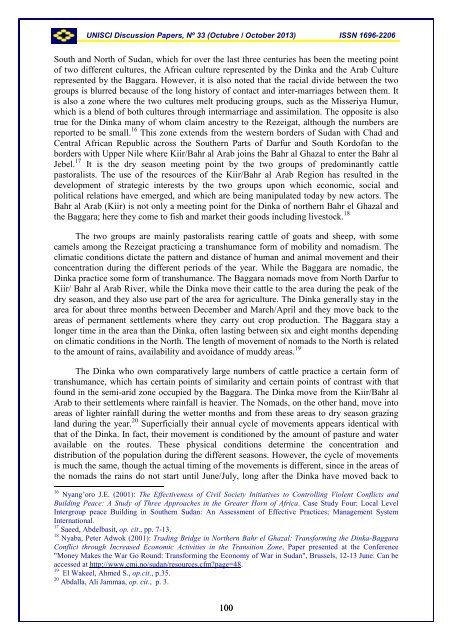UNISCI - Universidad Complutense de Madrid
UNISCI - Universidad Complutense de Madrid
UNISCI - Universidad Complutense de Madrid
You also want an ePaper? Increase the reach of your titles
YUMPU automatically turns print PDFs into web optimized ePapers that Google loves.
<strong>UNISCI</strong> Discussion Papers, Nº 33 (Octubre / October 2013) ISSN 1696-2206South and North of Sudan, which for over the last three centuries has been the meeting pointof two different cultures, the African culture represented by the Dinka and the Arab Culturerepresented by the Baggara. However, it is also noted that the racial divi<strong>de</strong> between the twogroups is blurred because of the long history of contact and inter-marriages between them. Itis also a zone where the two cultures melt producing groups, such as the Misseriya Humur,which is a blend of both cultures through intermarriage and assimilation. The opposite is alsotrue for the Dinka many of whom claim ancestry to the Rezeigat, although the numbers arereported to be small. 16 This zone extends from the western bor<strong>de</strong>rs of Sudan with Chad andCentral African Republic across the Southern Parts of Darfur and South Kordofan to thebor<strong>de</strong>rs with Upper Nile where Kiir/Bahr al Arab joins the Bahr al Ghazal to enter the Bahr alJebel. 17 It is the dry season meeting point by the two groups of predominantly cattlepastoralists. The use of the resources of the Kiir/Bahr al Arab Region has resulted in the<strong>de</strong>velopment of strategic interests by the two groups upon which economic, social andpolitical relations have emerged, and which are being manipulated today by new actors. TheBahr al Arab (Kiir) is not only a meeting point for the Dinka of northern Bahr el Ghazal andthe Baggara; here they come to fish and market their goods including livestock. 18The two groups are mainly pastoralists rearing cattle of goats and sheep, with somecamels among the Rezeigat practicing a transhumance form of mobility and nomadism. Theclimatic conditions dictate the pattern and distance of human and animal movement and theirconcentration during the different periods of the year. While the Baggara are nomadic, theDinka practice some form of transhumance. The Baggara nomads move from North Darfur toKiir/ Bahr al Arab River, while the Dinka move their cattle to the area during the peak of thedry season, and they also use part of the area for agriculture. The Dinka generally stay in thearea for about three months between December and March/April and they move back to theareas of permanent settlements where they carry out crop production. The Baggara stay alonger time in the area than the Dinka, often lasting between six and eight months <strong>de</strong>pendingon climatic conditions in the North. The length of movement of nomads to the North is relatedto the amount of rains, availability and avoidance of muddy areas. 19The Dinka who own comparatively large numbers of cattle practice a certain form oftranshumance, which has certain points of similarity and certain points of contrast with thatfound in the semi-arid zone occupied by the Baggara. The Dinka move from the Kiir/Bahr alArab to their settlements where rainfall is heavier. The Nomads, on the other hand, move intoareas of lighter rainfall during the wetter months and from these areas to dry season grazingland during the year. 20 Superficially their annual cycle of movements appears i<strong>de</strong>ntical withthat of the Dinka. In fact, their movement is conditioned by the amount of pasture and wateravailable on the routes. These physical conditions <strong>de</strong>termine the concentration anddistribution of the population during the different seasons. However, the cycle of movementsis much the same, though the actual timing of the movements is different, since in the areas ofthe nomads the rains do not start until June/July, long after the Dinka have moved back to16 Nyang’oro J.E. (2001): The Effectiveness of Civil Society Initiatives to Controlling Violent Conflicts andBuilding Peace: A Study of Three Approaches in the Greater Horn of Africa. Case Study Four: Local LevelIntergroup peace Building in Southern Sudan: An Assessment of Effective Practices; Management SystemInternational.17 Saeed, Ab<strong>de</strong>lbasit, op. cit., pp. 7-13.18 Nyaba, Peter Adwok (2001): Trading Bridge in Northern Bahr el Ghazal: Transforming the Dinka-BaggaraConflict through Increased Economic Activities in the Transition Zone, Paper presented at the Conference"Money Makes the War Go Round: Transforming the Economy of War in Sudan", Brussels, 12-13 June. Can beaccessed at http://www.cmi.no/sudan/resources.cfm?page=48.19 El Wakeel, Ahmed S., op.cit., p.35.20 Abdalla, Ali Jammaa, op. cit., p. 3.100
















